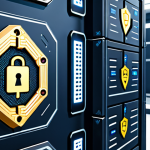Remember when digital currency felt like a fringe topic, something only tech-savvy folks whispered about? I certainly do. It was easy to dismiss then, but fast forward to today, and it’s undeniable: these aren’t just speculative assets anymore.
We’re talking about a fundamental shift, creating entirely new economic avenues and redefining value itself. The sheer potential, when you stop and think about how they’re reshaping industries from finance to art, is absolutely mind-boggling.
Let’s find out precisely how. Honestly, when I first dipped my toes into understanding things like Decentralized Finance (DeFi) or Non-Fungible Tokens (NFTs), it felt like trying to grasp smoke.
But watching innovative projects leverage blockchain for everything from peer-to-peer lending to truly owning digital art, I began to see the tangible economic impact.
We’re not just talking about quick gains; this is about reducing transaction costs, increasing financial inclusion for billions globally, and even creating entirely new revenue streams for creators through tokenization.
Think about it: a small artist can now directly sell a unique digital piece, cutting out layers of intermediaries, and that’s genuinely transformative.
While challenges like regulatory uncertainty and scalability persist – and believe me, they’re real hurdles – the ongoing development in areas like Layer 2 solutions and central bank digital currencies (CBDCs) paints a vivid picture of a future where digital money is seamlessly integrated into our daily lives.
I envision a world where your smart contracts manage everything from your mortgage payments to your coffee purchases, all transparently and efficiently, making the traditional banking system feel almost archaic.
The economic value isn’t just in the coins themselves, but in the infrastructure they build and the innovative services they enable.
Redefining Financial Access: DeFi’s Unstoppable Rise

When I first heard the term “Decentralized Finance,” or DeFi, my mind immediately went to this image of disrupting the old guard. And honestly, it’s happening.
For too long, traditional financial systems have operated behind closed doors, with layers of intermediaries, opaque fees, and often, a hefty dose of exclusion for billions around the globe.
I’ve personally seen friends struggle with exorbitant international transfer fees just to send money back home, or small businesses unable to secure loans because they didn’t fit neatly into a bank’s rigid criteria.
This is where DeFi steps in, fundamentally challenging that paradigm. It’s about leveraging blockchain technology to create an open, transparent, and accessible financial system where anyone, anywhere, with an internet connection, can participate.
We’re talking about peer-to-peer lending platforms that bypass banks, decentralized exchanges (DEXs) that let you trade assets without a central broker, and automated market makers (AMMs) that provide liquidity to the ecosystem.
It feels revolutionary because, in many ways, it truly is. It’s not just a technological upgrade; it’s a philosophical shift towards financial self-sovereignty.
1. Breaking Down Banking Barriers
My own journey into DeFi began with a simple curiosity about how it could genuinely impact financial inclusion. What I discovered was a powerful answer to the challenges faced by the unbanked and underbanked populations worldwide.
Imagine a farmer in a remote village, previously unable to access credit or save securely, now able to participate in a global lending pool directly from their smartphone, earning interest on their savings or taking out a microloan with transparent, pre-determined terms.
This isn’t science fiction; it’s already a reality. The costs associated with traditional banking – account maintenance fees, transaction charges, or simply the geographic barriers to physical branches – are significantly reduced or eliminated.
Instead of trusting a centralized institution that might fail or freeze your assets, you interact directly with smart contracts, immutable code that executes exactly as programmed.
This shift from “trusting a bank” to “trusting code” might sound abstract, but in practice, it means unparalleled access and security for those who need it most, empowering individuals who were once on the fringes of the global economy.
2. From Lending to Liquidity: A New Financial Ecosystem
The breadth of innovation within DeFi still astounds me. It’s not just about simple money transfers; we’re talking about an entire burgeoning financial ecosystem mirroring, and in many ways surpassing, traditional finance.
I remember my initial confusion when encountering terms like “yield farming” or “liquidity providing,” but once you dive in, you see the genius. Think about lending platforms like Aave or Compound, where you can instantly borrow or lend cryptocurrencies without the need for a credit check or lengthy application process, all governed by decentralized protocols.
Then there are decentralized exchanges like Uniswap or SushiSwap, which allow you to swap one digital asset for another instantly and with far lower fees than traditional exchanges, because you’re interacting with a pool of assets supplied by other users, not a central order book.
This concept of pooled liquidity, where anyone can contribute assets and earn a share of trading fees, has unlocked entirely new avenues for passive income and capital efficiency.
It feels like we’re witnessing the birth of a more efficient, transparent, and incredibly dynamic financial future right before our eyes, one that’s open 24/7 and globally accessible.
Empowering Creators and Communities: The NFT Revolution
If DeFi is reshaping finance, then Non-Fungible Tokens, or NFTs, are absolutely transforming the creative and cultural landscape, giving power back to individuals in a way I frankly never thought possible.
Before NFTs, digital art was infinitely reproducible, often leading to a devaluation of the artist’s work. How do you prove ownership or uniqueness of a JPEG?
You couldn’t, not really. But NFTs changed that narrative entirely, creating provable scarcity and ownership for digital assets. I’ve seen countless artists, musicians, and designers, who once struggled to make ends meet through traditional channels, suddenly find incredible success and a direct connection with their audience through NFTs.
It’s more than just a transaction; it’s a direct relationship, allowing creators to retain a higher percentage of their sales and even earn royalties on secondary market sales, something virtually unheard of in traditional art markets.
This isn’t just a trend; it’s a fundamental shift in how value is perceived and exchanged in the digital realm.
1. Giving Power Back to the Artists and Innovators
I’ve always believed that creators deserve to be fairly compensated for their work, and the NFT space has delivered on that promise in spades. It’s not just about JPEGs of monkeys anymore; it’s about digital art, music albums, virtual fashion, gaming assets, and even unique moments in sports history being tokenized.
Imagine a musician releasing their album as an NFT, directly selling it to fans, cutting out record labels and distributors entirely. Or a game developer creating in-game items as NFTs, allowing players to truly own their digital swords or skins, and even resell them on open marketplaces.
This direct creator-to-consumer model fosters an unparalleled sense of ownership and connection. I’ve spoken with artists who, for the first time in their careers, feel a genuine sense of financial independence and creative freedom because they’re no longer beholden to gatekeepers.
It’s a powerful testament to how digital ownership can genuinely transform livelihoods.
2. Community and Ownership: The Social Fabric of Web3
What fascinates me even more than the individual artist success stories is the incredible sense of community that NFTs foster. When you buy an NFT from a collection, you’re not just acquiring a digital asset; you’re often gaining access to an exclusive community, a DAO (Decentralized Autonomous Organization), or even future experiences.
I’ve seen vibrant online communities spring up around NFT projects, united by shared interests and a collective ownership of digital culture. These communities often have a direct say in the project’s future through governance tokens, allowing members to vote on proposals and steer the direction of the ecosystem.
It’s a profound shift from passive consumption to active participation, transforming how brands, artists, and fans interact. This collective ownership, where everyone has a stake, is building a new kind of social fabric in the digital world, one that feels far more engaging and equitable than anything we’ve seen before.
Beyond Borders: Seamless Global Transactions
One of the most frustrating experiences I’ve had, and I’m sure many can relate, is dealing with slow, expensive, and often opaque international money transfers.
Sending funds across borders typically involves banks, SWIFT codes, multiple intermediaries, and days of waiting, all while racking up fees that feel like daylight robbery.
Digital currencies, however, completely flip this script. I remember testing out a small crypto transfer to a friend in another country; it cost pennies and arrived within minutes.
That experience alone crystallized the profound economic potential for cross-border payments. We’re talking about a world where remittances are no longer a financial burden for migrant workers, where businesses can transact globally without fear of prohibitive fees or delays, and where capital can flow freely and efficiently, stimulating economic growth everywhere.
1. Erasing the Lines: Faster, Cheaper Remittances
The impact of digital currencies on remittances is, in my opinion, one of their most significant humanitarian and economic contributions. Millions of people globally rely on sending money back to their families, and traditional services often charge exorbitant fees, eating into hard-earned wages.
When I saw the potential for digital currencies to reduce these costs by over 90% and cut transfer times from days to mere minutes, it felt like a true game-changer for economic inclusion.
It means more money stays with the families who need it most, directly improving their quality of life. This isn’t just about convenience; it’s about empowering individuals and strengthening economies by making capital more accessible and less costly to move across geographical boundaries.
It’s a real, tangible improvement in the lives of countless individuals.
2. Supply Chains Transformed: Transparency and Trust
Beyond individual remittances, the application of blockchain and digital currencies extends deeply into the world of global commerce, particularly within supply chains.
I’ve always been fascinated by how complex our global supply networks are, and how prone they are to inefficiencies, fraud, and a lack of transparency.
Imagine tracking a product from its raw materials to the consumer’s hands, with every step recorded immutably on a blockchain. This means you can verify the origin of goods, ensure ethical sourcing, and minimize counterfeit products.
Companies like IBM and Walmart have already piloted blockchain solutions to track food products, dramatically reducing the time it takes to trace contamination.
This isn’t just about efficiency; it’s about building unparalleled trust between consumers and producers, and creating a more resilient, verifiable global economy.
The economic value here is immense, reducing losses from fraud, improving recall efficiency, and fostering greater consumer confidence.
| Economic Impact Area | Traditional System | Digital Currency/Blockchain Impact |
|---|---|---|
| Transaction Speed | Days (for international) | Minutes/Seconds |
| Transaction Cost | High fees (especially cross-border) | Significantly lower, often negligible |
| Financial Inclusion | Limited, requires bank access | Global, accessible with internet |
| Creator Royalties | Minimal or non-existent | Programmable, automatic on resales |
| Supply Chain Transparency | Opaque, prone to fraud | Verifiable, immutable records |
| Asset Liquidity | Often illiquid, high barriers | Fractional ownership, 24/7 markets |
Tokenizing the Tangible: Unlocking New Asset Classes
The concept of “tokenization” might sound a bit abstract, but it’s one of the most exciting developments I’ve witnessed in the digital currency space.
Essentially, it means representing real-world assets – anything from a piece of real estate or fine art to intellectual property or even a share in a company – as digital tokens on a blockchain.
This isn’t just a technical trick; it’s a profound economic innovation that promises to unlock liquidity, increase accessibility, and create entirely new markets for assets that were once difficult to buy, sell, or even understand.
Think about it: owning a fraction of a multi-million dollar painting, or investing in a commercial property with a relatively small amount of capital.
This was largely impossible for the average person before, but tokenization is making it a reality, democratizing investment opportunities and bringing previously illiquid assets into a fluid, global marketplace.
The potential for wealth creation and financial inclusion here is absolutely staggering.
1. Fractional Ownership: Making High-Value Assets Accessible
I’ve always felt that access to high-value investments was largely reserved for the ultra-wealthy. But with tokenization, that barrier is dissolving. Imagine being able to own a small share of a luxury apartment building in New York, or a fractional piece of a rare diamond, without needing to put down millions of dollars.
This is what fractional ownership through asset tokenization enables. It breaks down large, expensive assets into smaller, more affordable digital units, allowing a broader range of investors to participate.
This doesn’t just democratize wealth; it also increases the liquidity of these assets, as they can be traded more easily on secondary markets. I’ve seen this play out in the art world, where masterpieces are now being tokenized, allowing collectors to own a piece of history without buying the entire work.
It’s a revolutionary way to think about investment and ownership, making previously exclusive opportunities available to everyone.
2. Loyalty and Rewards Reimagined: Digital Incentives
Beyond traditional assets, tokenization is also breathing new life into concepts like customer loyalty programs and digital incentives. If you’re anything like me, you’ve probably accumulated countless loyalty points from airlines, coffee shops, or retail stores that are often difficult to redeem, expire, or have limited utility.
But imagine if these loyalty points were actually digital tokens on a blockchain. They could be traded, exchanged for other tokens, or even used across different platforms.
I’ve seen some exciting early examples where brands are issuing their own tokens to reward customers, creating a more engaging and valuable loyalty ecosystem.
This approach transforms static points into dynamic, tradable assets, fostering a deeper connection between businesses and their communities. It’s not just about earning discounts anymore; it’s about truly owning a piece of the brand’s ecosystem and participating in its success, creating a more robust and liquid economy around consumer engagement.
The Dawn of Programmable Money: Smart Contracts in Action
The term “programmable money” sounds a bit like something out of a sci-fi movie, but trust me, it’s becoming a very real and impactful part of our economic landscape.
At its core, it refers to money that can be programmed to behave in certain ways based on pre-defined conditions, all thanks to smart contracts. Imagine a world where your rent is paid automatically only if your landlord fulfills their maintenance obligations, or where insurance payouts are triggered instantly and automatically once specific conditions (like flight delays, verified by an external data feed) are met.
This isn’t just about automating payments; it’s about embedding logic directly into financial transactions, creating unprecedented levels of efficiency, transparency, and trust, removing the need for costly intermediaries and reducing human error.
My mind often goes to the sheer potential for innovation when money itself becomes a dynamic, intelligent entity.
1. Automating Agreements: Beyond Human Intervention
For centuries, complex agreements and financial transactions have relied heavily on lawyers, notaries, and other intermediaries to ensure trust and enforcement.
Smart contracts are poised to significantly disrupt this model. I’ve witnessed firsthand how they can automate escrow services, releasing funds only when both parties have fulfilled their obligations.
Consider intellectual property: a smart contract could automatically distribute royalties to creators every time their work is streamed or used, ensuring fair and instant compensation without bureaucratic delays.
This capability to self-execute based on code, immutably recorded on a blockchain, removes the need for human intervention in many processes, drastically cutting costs and speeding up transactions.
It’s truly transformative for industries ranging from legal services to real estate, making agreements more efficient, transparent, and less prone to disputes.
2. The Future of Identity and Data Ownership
While often discussed in the context of money, smart contracts also play a pivotal role in the burgeoning field of self-sovereign identity and data ownership.
Think about your personal data scattered across countless websites and companies, often used without your explicit consent or benefit. With blockchain and smart contracts, you could own your digital identity, granting access to your data only when you choose, and even monetizing it if you wish.
I envision a future where my health records, professional certifications, and even my online browsing history are securely stored on a blockchain, accessible only by me, and shared only with my explicit permission.
This shifts power from centralized entities back to the individual, creating new economic models where people are compensated for their data rather than simply having it harvested.
This concept of truly owning your digital footprint is not just about privacy; it’s about unlocking new economic opportunities for individuals to control and monetize their most valuable asset: their information.
Navigating the Digital Frontier: Challenges and Innovation
It would be naive to paint a picture of purely limitless potential without acknowledging the very real hurdles and complexities that digital currencies face.
As someone who’s been deeply involved in this space, I’ve seen the euphoria of soaring prices and the anxiety of sudden corrections. I’ve grappled with confusing regulations and worried about the security of my own digital assets.
These aren’t minor concerns; they are critical challenges that must be addressed for mainstream adoption. However, what gives me immense hope is the relentless pace of innovation and the sheer dedication of developers and policymakers working to overcome these obstacles.
It’s a bumpy road, no doubt, but the progress we’re making is undeniable.
1. The Hurdles We Face: Security, Regulation, and Scalability
Let’s be honest, the digital asset space isn’t without its risks. Security is paramount, and unfortunately, we’ve seen high-profile hacks and scams that undermine trust.
User education on safeguarding private keys and understanding phishing attempts is critical, and frankly, we still have a long way to go there. Beyond security, regulatory uncertainty is a massive concern.
Different countries are approaching digital currencies in vastly different ways, creating a patchwork of rules that makes it difficult for businesses and individuals to navigate.
This lack of clarity stifles innovation in some areas and creates arbitrage opportunities in others. And then there’s scalability: early blockchains, like Bitcoin and Ethereum, weren’t designed to handle the transaction volume of a global financial system.
I’ve personally experienced network congestion and high transaction fees during peak times, which can be frustrating and counterproductive to the vision of accessible finance.
These are genuine technical and governance challenges that the community is actively working to solve.
2. The Path Forward: Layer 2 Solutions and CBDCs
Despite these challenges, the ingenuity of the blockchain community is constantly pushing the boundaries. The issue of scalability, for instance, is being vigorously addressed through “Layer 2” solutions like Lightning Network for Bitcoin or Optimism and Arbitrum for Ethereum.
These technologies process transactions off the main blockchain, then settle them in batches, dramatically increasing throughput and reducing costs. I’ve used Layer 2 solutions myself, and the speed and affordability are genuinely impressive.
Simultaneously, we’re seeing the emergence of Central Bank Digital Currencies (CBDCs), digital versions of national fiat currencies issued and regulated by central banks.
While different from decentralized cryptocurrencies, CBDCs represent a tacit acknowledgment from governments that digital money is the future, potentially offering benefits like faster payments and increased financial stability.
These parallel developments, both decentralized and centralized, paint a vibrant picture of a future where digital money is not just an alternative, but an integral part of our global financial infrastructure, continually evolving to address its limitations.
Looking Ahead: The Ubiquitous Digital Future
It’s easy to get caught up in the daily headlines and price fluctuations of digital currencies, but stepping back and looking at the bigger picture reveals something truly profound.
We are not just witnessing the rise of a new asset class; we are observing the fundamental re-architecture of how value is created, exchanged, and owned across the globe.
From decentralized applications that are building new forms of financial services to non-fungible tokens that are empowering a new generation of creators, the economic impact is already far-reaching and continues to expand at an astonishing pace.
My personal conviction, based on years of observing this space, is that digital currencies and their underlying technologies will cease to be a niche topic and become an indispensable part of our daily lives, as seamlessly integrated as the internet itself.
1. From Niche to Necessity: Integration into Daily Life
I genuinely believe that the era of digital currency being a niche fascination for tech enthusiasts is rapidly fading. I envision a future, perhaps sooner than many expect, where you pay for your coffee with a digital wallet that leverages blockchain technology, manage your property deeds through tokenized assets, and receive your salary directly into a smart contract that automatically allocates funds to savings, investments, and bills.
This isn’t just about convenience; it’s about unparalleled efficiency, transparency, and control over our personal finances and assets. The infrastructure is being built, the regulations are slowly taking shape, and the user experience is constantly improving.
It will feel less like a “crypto transaction” and more like just “a transaction,” utterly unremarkable in its seamless integration into our financial routines, just as swiping a card became second nature after cash.
2. A Collaborative Vision: Shaping the Next Economy
What truly excites me about the future of digital currencies is the collaborative spirit that drives their development. This isn’t a top-down revolution; it’s a global, open-source movement where developers, researchers, entrepreneurs, and even everyday users are contributing to building this new economic paradigm.
I’ve been privileged to witness hackathons, online forums, and global conferences where brilliant minds converge to solve complex problems and build innovative solutions.
This collective intelligence, driven by shared values of decentralization and open access, is a powerful force for change. It promises a future where economic opportunities are more evenly distributed, where value creation is more transparent, and where individuals have greater control over their financial destinies.
It’s a bold vision, certainly, but one that, based on everything I’ve seen, feels increasingly inevitable and profoundly impactful.
Closing Thoughts
As we stand on the cusp of this digital revolution, it’s clear that the economic value isn’t just in the individual coins or tokens, but in the profound re-imagining of our financial world.
From empowering creators and unlocking global access to democratizing investment and automating complex agreements, digital currencies are building an entirely new economic infrastructure.
I truly believe that embracing this shift isn’t just about technological adoption; it’s about unlocking a more equitable, efficient, and innovative future for everyone, everywhere.
The journey is just beginning, and the opportunities are boundless.
Useful Information
1. Start with Education: Before diving into investments, take the time to truly understand the core concepts of blockchain, cryptocurrencies, and smart contracts. There are countless free resources online, from reputable courses to community forums.
2. Prioritize Security: Your digital assets are your responsibility. Always use strong, unique passwords, enable two-factor authentication, and consider hardware wallets (cold storage) for significant holdings. Be extremely wary of unsolicited messages and phishing attempts.
3. Diversify and Research (DYOR): The crypto market can be volatile. Don’t put all your eggs in one basket. Always conduct your own thorough research into any project, token, or platform before committing your funds.
4. Understand the Use Cases: Digital currencies aren’t just for trading. Explore how they’re being used in DeFi, NFTs, supply chain management, and identity verification to grasp their real-world impact beyond price speculation.
5. Stay Informed on Regulation: The regulatory landscape for digital assets is constantly evolving. Keep an eye on news from financial authorities in your region, as new rules can significantly impact how you interact with this space.
Key Takeaways
The rise of digital currencies and blockchain technology is fundamentally redefining economic value by fostering greater financial inclusion, empowering creators through NFTs, and revolutionizing global transactions.
Decentralized Finance (DeFi) offers open and transparent financial services, while asset tokenization democratizes investment in high-value assets. Programmable money, driven by smart contracts, introduces unprecedented efficiency and automation into agreements.
While challenges in security, regulation, and scalability persist, continuous innovation through solutions like Layer 2 networks and the development of CBDCs point towards a future where digital money is an integral, seamless, and globally accessible component of our daily economic lives.
Frequently Asked Questions (FAQ) 📖
Q: Beyond just speculation, how are digital currencies, especially things like DeFi and NFTs, truly creating new economic opportunities for regular people?
A: This is where it gets genuinely exciting for me! I mean, when I first heard about NFTs, I was skeptical, thinking it was just art for the ultra-rich, but I’ve personally seen it empower creators in such profound ways.
Think about a small indie musician or a digital artist who might have struggled for years to get noticed or fairly compensated. Now, they can mint a unique piece of their work, sell it directly to fans globally, and even earn royalties on future resales – it’s a radical shift from the old gatekeepers.
And DeFi? It’s like a whole parallel financial universe where you can access loans or earn interest without needing a traditional bank. I’ve seen countless people, myself included, explore peer-to-peer lending and borrowing, finding options that simply aren’t available through traditional channels, often with lower fees and more transparency.
It’s about leveling the playing field and giving everyone, not just big institutions, a slice of the economic pie.
Q: With all this potential, what are the most significant hurdles or lingering concerns that you believe digital currencies still face before truly becoming mainstream?
A: Honestly, anyone who says it’s all smooth sailing isn’t giving you the full picture. From my perspective, the two biggest issues looming over everything are regulatory uncertainty and scalability.
It still feels a bit like the Wild West out there sometimes; governments are wrestling with how to classify and regulate these assets, and that constant flux can make businesses and individuals hesitant to dive in fully.
You don’t want your investments to suddenly be in a legal grey area, right? And then there’s scalability – can these networks truly handle billions of daily transactions, like a Visa or Mastercard does, without getting bogged down or expensive?
I’ve personally experienced slower transaction times when networks are congested, and that’s a real barrier to mass adoption. While Layer 2 solutions are showing immense promise in speeding things up, these are real, tangible hurdles that need persistent, innovative solutions before we see digital currencies truly embedded everywhere.
Q: You envision a future where digital money is seamlessly integrated into daily life. Could you paint a clearer picture of what that might actually look like for someone like me?
A: Oh, I often find myself imagining this, and it’s genuinely mind-boggling how much simpler our lives could become. Picture this: your smart contract isn’t just some abstract tech thing, it’s quietly managing your finances.
Your rent or mortgage payment automatically goes out on the first of the month, but instead of just transferring money, the smart contract verifies all conditions are met before the payment is released, all transparently on a blockchain.
Or, something as simple as buying your morning coffee: no fumbling for cards, no worrying about small change, just a quick tap of your phone, and a micro-payment instantly settles with near-zero fees.
I mean, imagine your car automatically paying for its own parking as it enters a garage, or your streaming service automatically adjusting its subscription based on your exact usage.
It’s not just about payments; it’s about an invisible, hyper-efficient layer of trust and automation woven into the fabric of daily transactions, making the traditional banking system feel almost archaic in comparison.
The economic value isn’t just in the money itself, but in the incredible efficiency and transparency it brings to every single exchange.
📚 References
Wikipedia Encyclopedia
구글 검색 결과
구글 검색 결과
구글 검색 결과
구글 검색 결과
구글 검색 결과






